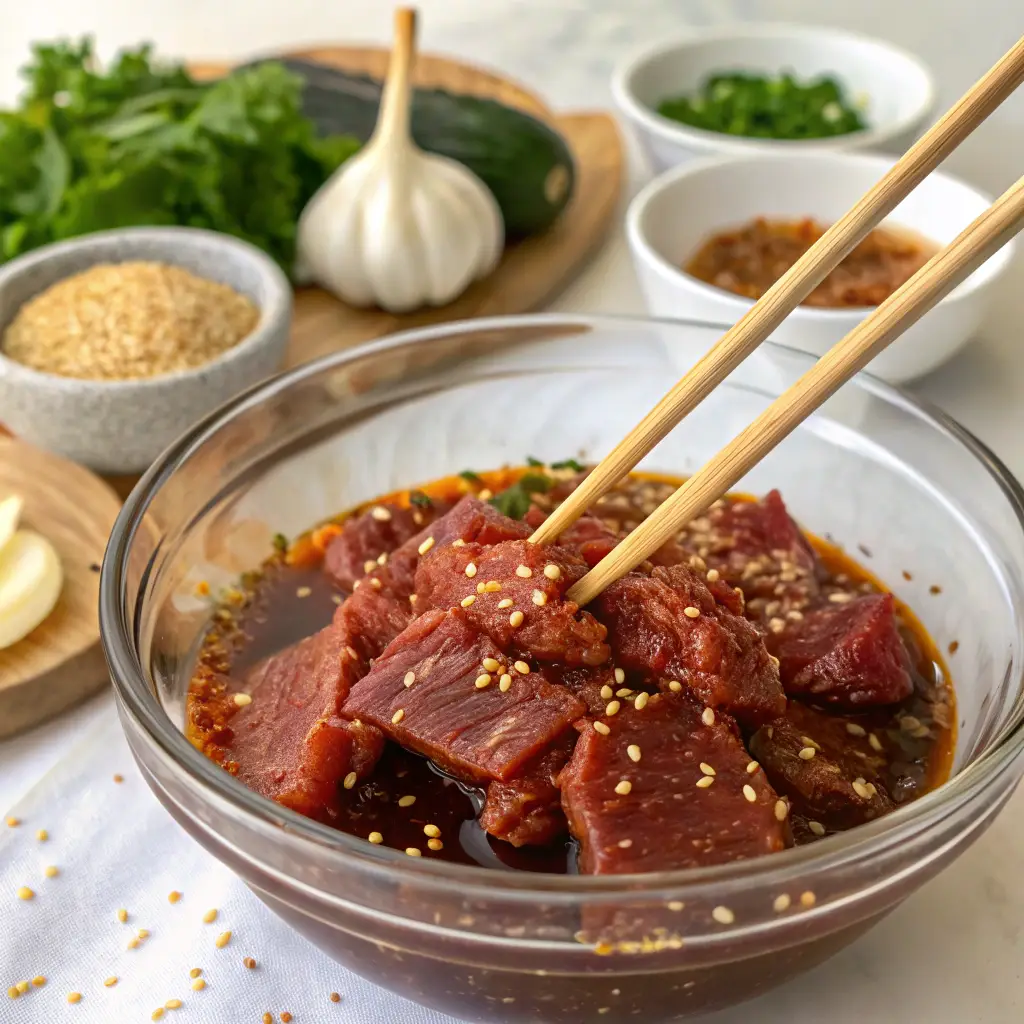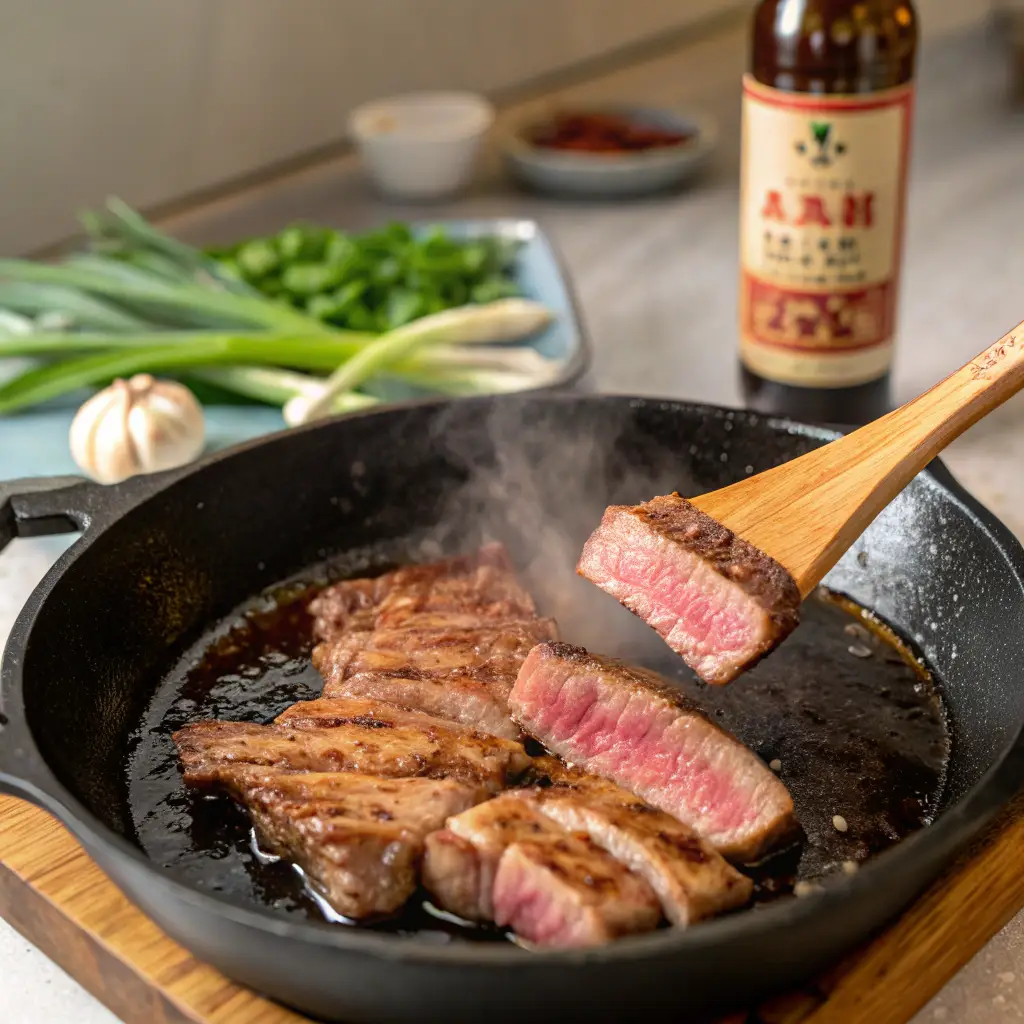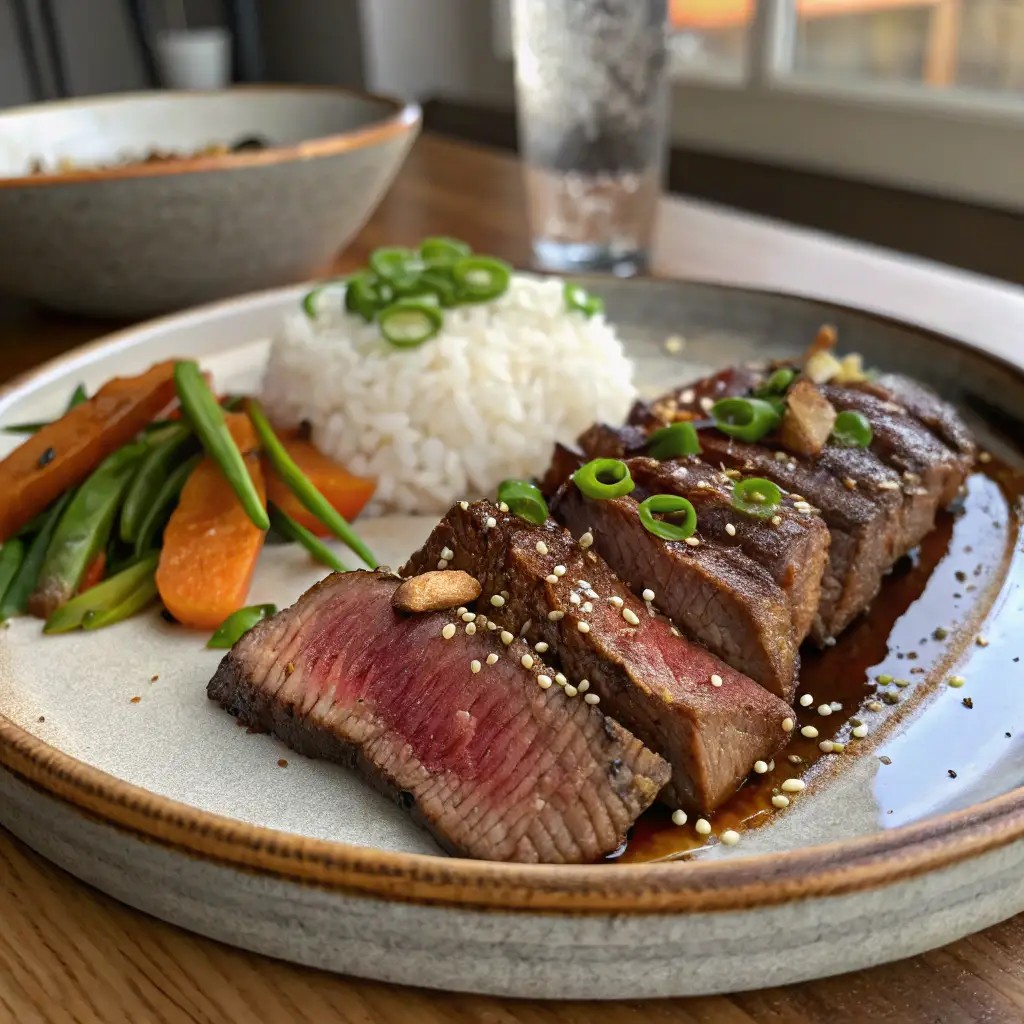Have you ever wished for a meal that’s quick to prepare, packed with flavor, and feels like a gourmet dish? Thin-sliced beef is your new best friend in the kitchen! Whether you’re whipping up a sizzling stir-fry, rolling tender beef into wraps, or layering it for a perfect sandwich, this ingredient is all about convenience and taste. First, it cooks in minutes, making it perfect for busy days. Then, it soaks up marinades beautifully, giving you endless ways to enjoy it. Plus, it’s a lean, protein-packed option that keeps your meals both delicious and healthy.
Now, imagine biting into perfectly seared, melt-in-your-mouth beef with just the right balance of seasoning. Sounds amazing, right? That’s the magic of this versatile cut. You can grill it, sauté it, or even enjoy it raw in dishes like carpaccio. Next, we’ll dive into how to cook it, what dishes to try, and how to bring out its best flavors—so keep reading!
Table of Contents
astering the Art of Cooking Thin-Sliced Beef
Techniques for Achieving the Perfect Sear
Getting that perfect sear on thin-sliced beef is easier than you think! First, make sure your pan is hot—really hot. This helps lock in the juices and gives the meat a beautiful golden crust. Next, spread the slices in a single layer. If they overlap, they’ll steam instead of searing. Then, cook for just a few seconds on each side. Thin cuts cook super fast, so keep an eye on them! Also, use a high-smoke-point oil like avocado or vegetable oil. This prevents burning and keeps the flavors pure. Finally, don’t move the beef too much. Let it sit and develop that crispy, caramelized edge before flipping. Once done, remove it from the heat immediately. Overcooked beef can turn chewy. With these simple tricks, you’ll always have juicy, flavorful bites. Now, let’s talk about boosting flavor with the right marinades!
Enhancing Flavor with Marinades and Seasonings

Marinades take thin-sliced beef from good to unforgettable! First, choose an acidic base like soy sauce, vinegar, or citrus juice. This helps break down the fibers, making the meat tender. Next, add oils and spices. Garlic, ginger, and black pepper are classic choices, but feel free to get creative! Also, don’t forget a touch of sweetness—honey or brown sugar helps balance the flavors. Then, let the beef soak for at least 30 minutes. If you have more time, a few hours in the fridge works even better. However, don’t marinate too long, or the meat may break down too much. Finally, pat the slices dry before cooking. This ensures a proper sear instead of steaming. With the right marinade, your beef will be bursting with flavor! Now, let’s dive into some delicious dishes you can make.
Popular Dishes Featuring Thin-Sliced Beef

Classic Asian Stir-Fries and Hot Pot Creations
Thin-sliced beef is a staple in many Asian dishes. First, stir-fries make quick and flavorful meals. Just toss the beef into a hot pan with fresh veggies and soy-based sauce, and you’ve got a restaurant-worthy dish. Then, there’s hot pot—a fun way to cook thin slices right at the table. Just dip them into simmering broth for a few seconds, and they’re ready! Also, Mongolian beef and Korean bulgogi are must-tries. Both use thin slices for tender, flavorful bites. Additionally, Japanese sukiyaki and shabu-shabu highlight beef’s natural richness with minimal seasoning. Whether you crave something quick or an interactive meal, these dishes showcase beef in the best way. Next, let’s explore how this ingredient shines in Western cuisine!
Western Favorites: Cheesesteaks and Carpaccio
Thin-sliced beef isn’t just for Asian dishes—it’s a star in Western cuisine, too! First up, the Philly cheesesteak. This classic sandwich combines sizzling beef, melted cheese, and soft bread for the ultimate comfort food. Then, there’s beef carpaccio—a raw dish that’s surprisingly simple. Thin slices are drizzled with olive oil, lemon juice, and parmesan for an elegant appetizer. Also, roast beef sandwiches use thin cuts to create juicy, flavorful bites. In addition, fajitas and tacos benefit from thinly sliced beef, offering a smoky, grilled flavor in every bite. Whether you want something hearty or light, this versatile cut delivers. Now, let’s talk about choosing the best cuts for thin-sliced beef!
Best Cuts for Thin-Sliced Beef and How to Prepare Them
Choosing the Right Cut for Tenderness and Taste
Not all beef cuts are created equal! First, ribeye is a fantastic choice. It has the perfect balance of fat and tenderness. Then, sirloin offers a leaner option while still being flavorful. Also, flank and skirt steak work great, especially for marinated dishes. Additionally, eye of round is a budget-friendly cut, but it needs proper slicing and marination. No matter the cut, slicing against the grain is key. This shortens the muscle fibers, making the beef tender instead of chewy. Finally, always choose fresh, high-quality meat. The better the beef, the better the dish! Now that you know the best cuts, let’s discuss how to slice them perfectly.
Knife Skills and Tools for Perfectly Thin Slices
Slicing beef thinly is easier with the right tools! First, use a sharp knife. A dull blade will tear the meat instead of creating clean cuts. Next, slightly freeze the beef for 20–30 minutes. This firms it up, making it easier to slice thin. Then, always cut against the grain. This shortens the fibers, making the meat more tender. Also, a slicing knife with a long, thin blade works best. It allows for smooth, even cuts. In addition, using a meat slicer can speed up the process if you prepare large batches. Finally, practice makes perfect! The more you slice, the better your technique will get. Now, let’s explore why thin-sliced beef is not just tasty but also healthy!
Health Benefits and Nutritional Profile of Thin-Sliced Beef
High-Protein, Low-Fat Options for a Balanced Diet
Thin-sliced beef is not just delicious—it’s healthy too! First, it’s packed with protein, helping to build muscle and keep you full longer. Next, lean cuts like sirloin and eye of round are low in fat, making them a great option for balanced meals. Also, beef provides essential amino acids, which your body needs for repair and growth. In addition, it’s a great source of iron, helping to boost energy and prevent fatigue. Cooking it with minimal oil keeps it light while still flavorful. Whether you’re trying to stay fit or just eat healthier, thin-sliced beef is a great choice. Now, let’s dive into the specific nutrients that make it a powerhouse!
Essential Nutrients and Their Role in Muscle Growth
Thin-sliced beef is loaded with essential nutrients! First, it’s rich in iron, which helps transport oxygen in the body. This keeps you energized throughout the day. Next, it’s a great source of B vitamins, supporting brain function and metabolism. Also, zinc in beef strengthens the immune system, helping you stay healthy. In addition, it contains creatine, which boosts muscle growth and recovery. If you’re active, this is a great protein source to fuel workouts. Finally, beef provides collagen, which supports joint health and skin elasticity. With so many benefits, it’s easy to see why this cut is a nutritional powerhouse. Now, let’s explore where to buy and how to store it!
Where to Buy and How to Store Thin-Sliced Beef
Selecting Quality Meat from Butchers and Supermarkets
Finding the best thin-sliced beef starts with knowing where to look! First, visit a trusted butcher. They often offer fresh, high-quality cuts and can slice them to your preference. Next, check your local supermarket’s meat section. Look for bright red beef with minimal fat. Also, consider buying from specialty Asian markets. They often have pre-sliced options perfect for stir-fries and hot pots. In addition, online meat delivery services provide fresh beef straight to your door. No matter where you buy, freshness is key. Always check the packaging date and avoid meat with excessive liquid. Now, let’s talk about storing it properly to keep it fresh longer!
Proper Storage Techniques to Maintain Freshness
Storing thin-sliced beef correctly keeps it fresh and tasty! First, keep it in the coldest part of your fridge if you plan to use it within two days. Next, for longer storage, wrap it tightly and freeze it. Also, vacuum sealing helps prevent freezer burn and extends shelf life. In addition, label the packaging with the date to track freshness. When ready to cook, thaw it in the fridge overnight. Avoid microwaving, as it can make the texture tough. Finally, always store leftovers in an airtight container to maintain flavor. With these simple tips, your beef will stay fresh and delicious every time!
To further explore the versatility of thin-sliced beef, you’ll love trying it in comforting and creamy dishes. One perfect example is Beef Stroganoff—a classic dish where tender slices of beef are simmered in a rich, creamy mushroom sauce and served over pasta or rice. If you’re looking for a hearty meal that brings out the best in thin-sliced beef, this recipe is a must-try!
FAQs
What is a thin-sliced beef called?
Thin-sliced beef goes by different names depending on the dish or cuisine. First, in Japanese cooking, it’s often called “shabu-shabu beef” or “sukiyaki beef.” Next, in Korean cuisine, it’s known as “bulgogi beef.” Also, in Western cooking, thin slices are commonly used for dishes like Philly cheesesteaks or carpaccio. In addition, butchers may label it as “minute steak” or “stir-fry beef.” No matter what it’s called, thin-sliced beef cooks fast and soaks up flavors beautifully. It’s perfect for quick meals, making it a kitchen essential! Now, let’s talk about what the best cuts for thin slicing are.
What is a thin cut of beef called?
Thin cuts of beef have different names based on their thickness and use. First, “minute steak” is a common term for very thinly sliced beef. Next, “carpaccio” refers to raw beef sliced paper-thin. Also, in Asian cooking, thin slices are labeled as “hot pot beef” or “stir-fry beef.” In addition, some butchers sell “shaved steak,” which works great for sandwiches and stir-fries. No matter the name, thin cuts cook fast and stay tender with the right preparation. They’re a must-have for quick and flavorful meals! Now, let’s find out which cuts work best for slicing thin.
What is the best cut of beef to thinly slice?
The best cut depends on the dish! First, ribeye is great for rich, flavorful slices with marbling. Next, sirloin offers a leaner option but still stays juicy. Also, flank and skirt steak are perfect for marinating, making them great for stir-fries. In addition, eye of round is an affordable choice that works well when sliced thin. If you want extra tenderness, filet mignon is a fantastic option. No matter the cut, always slice against the grain. This helps break down the muscle fibers, keeping the beef tender. Now, let’s learn how to make thin-sliced beef extra tender!
How to make thin-cut beef tender?
Making thin-cut beef tender is easier than you think! First, slice against the grain. This shortens the muscle fibers and makes every bite softer. Next, marinate the beef. Ingredients like soy sauce, vinegar, or citrus juice help break down the meat. Also, don’t overcook it! Thin slices cook in seconds, so high heat and quick cooking work best. In addition, pounding the meat gently with a mallet can help. Another trick is to freeze it slightly before slicing—this ensures even cuts. With these simple steps, your thin-sliced beef will always be tender and delicious!
Conclusion
Thin-sliced beef is a game-changer in the kitchen! First, it cooks fast, making it perfect for busy days. Next, it soaks up flavors beautifully, making every bite rich and delicious. Also, its versatility means you can enjoy it in stir-fries, sandwiches, or even elegant dishes like carpaccio. In addition, choosing the right cut and mastering the best cooking techniques ensures tender, flavorful results every time. Now, it’s time to get cooking! Try new recipes, experiment with marinades, and enjoy the endless possibilities. With thin-sliced beef, every meal becomes an easy and tasty experience. Let’s get slicing!

